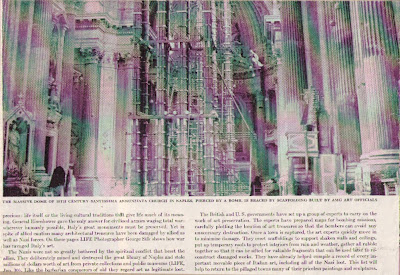 |
| Watercolor and pencil. |
 |
| Colored paper - all of it - in a dozen colors. |
 |
| The rest of these are pages from a contemporary photojournal, Life Magazine. The caption reads: "Italian workmen under direction of AMG dig for valuable fragments of sculpture, fresco, architectural ornament in bombed Capua Cathedral." Capua is inland a bit from the Allied landing beaches. |
 |
| "In the Palace of Caserta a British corporal takes a cat nap beneath a 16th Century statue of the Duke of Parma, who is being crowned by Victory. Built in 1752 for Charles III, the palace was recently turned into a public museum. Germans once used palace as official headquarters. When Nazis were routed, allied officials made it their headquarters." |
 |
| "The massive dome of 18th century Santissima Annunziata Church in Naples, pierced by a bomb, is braced by scaffolding built by AMG art officials." |
"Yet in spite of allied caution many architectural treasures have been damaged by allied as well as Nazi forces. On these pages LIFE Photographer George Silk shows how war has ravaged Italy's art."
"The Nazis were not so greatly bothered by the spiritual conflict that beset the allies. They deliberately mined and destroyed the great library of Naples and stole millions of dollars worth of art from private collections and public museums. . . The British and U.S. governments have set up a group of experts to carry on the work of art preservation. The experts have prepared maps for bombing missions, carefully plotting the location of art treasures so that the bombers can avoid any unnecessary damage. They erect scaffoldings to support shaken walls and ceilings, put up temporary roofs to protect interiors from rain and weather, gather all rubble together so that it can be sifted for valuable fragments that can be used later to reconstruct damaged works. They have already helped compile a record of every important movable piece of Italian art, including all of the Nazi loot. This list will help to return to the pillaged towns many of their priceless paintings and sculptures."
So we can date this issue of LIFE Magazine to late 1943.
 |
| Santissima Annunziata Maggiore, the nave today |
Robert M. Edsel has written two books about this, one being Monuments Men. So I'm thinking "AMG" refers to an "Allied Monuments Group." Previous to that he published Rescuing da Vinci.


No comments:
Post a Comment